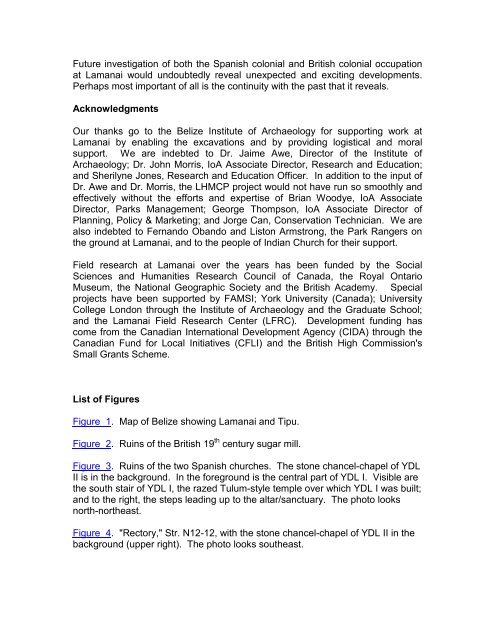Report submitted to FAMSI:
Report submitted to FAMSI:
Report submitted to FAMSI:
Create successful ePaper yourself
Turn your PDF publications into a flip-book with our unique Google optimized e-Paper software.
Future investigation of both the Spanish colonial and British colonial occupation<br />
at Lamanai would undoubtedly reveal unexpected and exciting developments.<br />
Perhaps most important of all is the continuity with the past that it reveals.<br />
Acknowledgments<br />
Our thanks go <strong>to</strong> the Belize Institute of Archaeology for supporting work at<br />
Lamanai by enabling the excavations and by providing logistical and moral<br />
support. We are indebted <strong>to</strong> Dr. Jaime Awe, Direc<strong>to</strong>r of the Institute of<br />
Archaeology; Dr. John Morris, IoA Associate Direc<strong>to</strong>r, Research and Education;<br />
and Sherilyne Jones, Research and Education Officer. In addition <strong>to</strong> the input of<br />
Dr. Awe and Dr. Morris, the LHMCP project would not have run so smoothly and<br />
effectively without the efforts and expertise of Brian Woodye, IoA Associate<br />
Direc<strong>to</strong>r, Parks Management; George Thompson, IoA Associate Direc<strong>to</strong>r of<br />
Planning, Policy & Marketing; and Jorge Can, Conservation Technician. We are<br />
also indebted <strong>to</strong> Fernando Obando and Lis<strong>to</strong>n Armstrong, the Park Rangers on<br />
the ground at Lamanai, and <strong>to</strong> the people of Indian Church for their support.<br />
Field research at Lamanai over the years has been funded by the Social<br />
Sciences and Humanities Research Council of Canada, the Royal Ontario<br />
Museum, the National Geographic Society and the British Academy. Special<br />
projects have been supported by <strong>FAMSI</strong>; York University (Canada); University<br />
College London through the Institute of Archaeology and the Graduate School;<br />
and the Lamanai Field Research Center (LFRC). Development funding has<br />
come from the Canadian International Development Agency (CIDA) through the<br />
Canadian Fund for Local Initiatives (CFLI) and the British High Commission's<br />
Small Grants Scheme.<br />
List of Figures<br />
Figure 1. Map of Belize showing Lamanai and Tipu.<br />
Figure 2. Ruins of the British 19 th century sugar mill.<br />
Figure 3. Ruins of the two Spanish churches. The s<strong>to</strong>ne chancel-chapel of YDL<br />
II is in the background. In the foreground is the central part of YDL I. Visible are<br />
the south stair of YDL I, the razed Tulum-style temple over which YDL I was built;<br />
and <strong>to</strong> the right, the steps leading up <strong>to</strong> the altar/sanctuary. The pho<strong>to</strong> looks<br />
north-northeast.<br />
Figure 4. "Rec<strong>to</strong>ry," Str. N12-12, with the s<strong>to</strong>ne chancel-chapel of YDL II in the<br />
background (upper right). The pho<strong>to</strong> looks southeast.
















